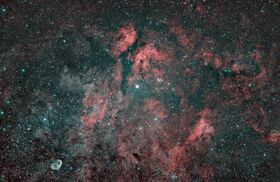Astronomy:RW Cygni
| Observation data Equinox J2000.0]] (ICRS) | |
|---|---|
| Constellation | Cygnus |
| Right ascension | 20h 28m 50.59027s[1] |
| Declination | 39° 58′ 54.4180″[1] |
| Apparent magnitude (V) | 8.05 - 9.70[2] |
| Characteristics | |
| Evolutionary stage | Red supergiant |
| Spectral type | M3-4Ia-Iab[3] |
| Variable type | SRc[2] |
| Astrometry | |
| Radial velocity (Rv) | −18.39±0.52[1] km/s |
| Proper motion (μ) | RA: –3.255[1] mas/yr Dec.: –5.511[1] mas/yr |
| Parallax (π) | 0.4602 ± 0.0897[1] mas |
| Distance | 1,620+40 −40[4] pc |
| Absolute magnitude (MV) | –6.41[5] |
| Details | |
| Radius | 1,000[6] R☉ |
| Luminosity | 126,000[4] - 160,000[6] L☉ |
| Temperature | 3,605±170[6] K |
| Other designations | |
| Database references | |
| SIMBAD | data |
RW Cygni is a semiregular variable star in the constellation Cygnus, about a degree east of 2nd magnitude γ Cygni. Its apparent magnitude varies between 8.05 and 9.70 and its spectral type between M3 and M4.
Distance
The Gaia Data Release 2 parallax for RW Cyg is 0.4602±0.0897 mas or a distance of around 2.2 kpc.[1] RW Cygni is assumed to be a member of the Cygnus OB9 Stellar Association and therefore around 3,600 light-years from the Solar System.[5][7] Newer observations based on the parallaxes of neighbouring OB stars give RW Cygni a distance of 1.62 kpc.[4]
Properties
RW Cygni is a luminous red supergiant with a bolometric luminosity more than 100,000 L☉.[8][5] Its spectral type is given in the General Catalogue of Variable Stars as M2-4Ia-Iab, covering the range of previously published values. It has been defined as a standard star for the MK spectral classification of M3-M4Ia-Iab.[3] In 2005, the effective temperature is directly calculated to be 3,600 K, giving a radius of 980 R☉.[5] An alternate calculation gives a higher temperature of 3,920 K and a correspondingly lower radius of 680 R☉.[8] More recent measurements based on its Gaia Data Release 2 parallax gives the similar effective temperature derived in 2005 and as well as a larger radius of 1,000 R☉, which would make RW Cygni one of the largest known stars.[6] Using the more conservative figure, if it was placed at the center of Solar System, it would be extend past the orbit of Mars and into the Asteroid Belt.
The initial mass of RW Cygni has been estimated from its position relative to theoretical stellar evolutionary tracks to be around 20 M☉.[8] Observations of its atmosphere suggest that it is losing mass at a rate of 3.2×10−6 M☉ per year.[10]
RW Cygni is classified as a semiregular variable star. It is given the subtype SRc, indicating that it is a cool supergiant.[2] Its brightness varies from extremes of magnitude +8.0 and +9.5 with a period of 580±80 d. No long secondary period has been detected.[11]
See also
References
- ↑ 1.0 1.1 1.2 1.3 1.4 1.5 1.6 Brown, A. G. A. (August 2018). "Gaia Data Release 2: Summary of the contents and survey properties". Astronomy & Astrophysics 616: A1. doi:10.1051/0004-6361/201833051. Bibcode: 2018A&A...616A...1G. Gaia DR2 record for this source at VizieR.
- ↑ 2.0 2.1 2.2 Samus, N. N. et al. (2009). "VizieR Online Data Catalog: General Catalogue of Variable Stars (Samus+ 2007-2013)". VizieR On-line Data Catalog: B/GCVS. Originally Published in: 2009yCat....102025S 1. Bibcode: 2009yCat....102025S.
- ↑ 3.0 3.1 Keenan, Philip C.; McNeil, Raymond C. (1989). "The Perkins catalog of revised MK types for the cooler stars". Astrophysical Journal Supplement Series 71: 245. doi:10.1086/191373. Bibcode: 1989ApJS...71..245K.
- ↑ 4.0 4.1 4.2 Davies, Ben; Beasor, Emma R. (March 2020). "The 'red supergiant problem': the upper luminosity boundary of Type II supernova progenitors" (in en). MNRAS 493 (1): 468–476. doi:10.1093/mnras/staa174. Bibcode: 2020MNRAS.493..468D.
- ↑ 5.0 5.1 5.2 5.3 Levesque, Emily M.; Massey, Philip; Olsen, K. A. G.; Plez, Bertrand; Josselin, Eric; Maeder, Andre; Meynet, Georges (2005). "The Effective Temperature Scale of Galactic Red Supergiants: Cool, but Not As Cool As We Thought". The Astrophysical Journal 628 (2): 973–985. doi:10.1086/430901. Bibcode: 2005ApJ...628..973L.
- ↑ 6.0 6.1 6.2 6.3 Messineo, M.; Brown, A. G. A. (2019). "A Catalog of Known Galactic K-M Stars of Class I Candidate Red Supergiants in Gaia DR2". The Astronomical Journal 158 (1): 20. doi:10.3847/1538-3881/ab1cbd. Bibcode: 2019AJ....158...20M.
- ↑ Famaey, B.; Jorissen, A.; Luri, X.; Mayor, M.; Udry, S.; Dejonghe, H.; Turon, C. (2005). "Local kinematics of K and M giants from CORAVEL/Hipparcos/Tycho-2 data. Revisiting the concept of superclusters". Astronomy and Astrophysics 405: 165. doi:10.1051/0004-6361:20041272. Bibcode: 2005A&A...430..165F.
- ↑ 8.0 8.1 8.2 Josselin, E.; Plez, B. (2007). "Atmospheric dynamics and the mass loss process in red supergiant stars". Astronomy and Astrophysics 469 (2): 671. doi:10.1051/0004-6361:20066353. Bibcode: 2007A&A...469..671J.
- ↑ "Hipparcos Tools Interactive Data Access". ESA. https://www.cosmos.esa.int/web/hipparcos/interactive-data-access.
- ↑ Mauron, N.; Josselin, E. (2011). "The mass-loss rates of red supergiants and the de Jager prescription". Astronomy and Astrophysics 526: A156. doi:10.1051/0004-6361/201013993. Bibcode: 2011A&A...526A.156M.
- ↑ Kiss, L. L.; Szabó, Gy. M.; Bedding, T. R. (2006). "Variability in red supergiant stars: Pulsations, long secondary periods and convection noise". Monthly Notices of the Royal Astronomical Society 372 (4): 1721–1734. doi:10.1111/j.1365-2966.2006.10973.x. Bibcode: 2006MNRAS.372.1721K.
 |



